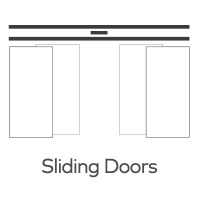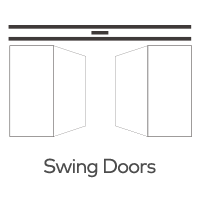Can safety sensors on automatic doors be used in residential settings?
Safety sensors are a critical component of automatic door systems, ensuring that doors open and close smoothly without causing harm to people or objects in their path. While these sensors are commonly found in commercial and public buildings, their application in residential settings is becoming increasingly popular. Here’s an exploration of how safety sensors can be used in residential automatic doors, the benefits they offer, and considerations for their implementation.
1. Benefits of Safety Sensors in Residential Settings
Safety sensors on automatic doors provide several advantages for homeowners:
Enhanced Accessibility:Automatic doors with safety sensors make it easier for individuals with mobility challenges, such as the elderly or those with disabilities, to move in and out of the home without having to manually open heavy doors.
Increased Convenience: For all residents, automatic doors eliminate the need to handle doorknobs or push doors open, which can be particularly useful when hands are full with groceries, children, or other items.
Improved Safety: Sensors prevent doors from closing on people or pets, reducing the risk of injury. They can also enhance home security by ensuring that doors are securely closed after someone enters or exits.
2. Types of Safety Sensors for Residential Automatic Doors
There are several types of safety sensors that can be integrated into residential automatic door systems:
Motion Sensors: These sensors detect movement near the door and trigger it to open. They are useful for high-traffic areas and provide hands-free operation.
Pressure Sensors: Installed on the floor or door frame, these sensors detect the presence of weight and ensure the door remains open as long as someone is in the doorway.
Infrared Sensors: These sensors use infrared light to detect objects in the path of the door. If an obstruction is detected, the door will stop closing and reverse direction to prevent injury.
Proximity Sensors: These sensors detect the presence of a person or object near the door without requiring physical contact, providing a touchless operation.
3. Applications in Residential Settings
Safety sensors can be integrated into various types of residential doors, enhancing functionality and safety:
Entry Doors: Main entrance doors equipped with safety sensors provide easy access for residents and visitors, especially beneficial for individuals with disabilities.
Interior Doors: Automatic doors inside the home, such as those leading to living rooms, kitchens, or bedrooms, can enhance convenience and accessibility.
Garage Doors: Safety sensors are already standard in many garage door openers, preventing the door from closing if an object or person is detected underneath.
Patio Doors: Sliding or swinging patio doors with safety sensors offer seamless access to outdoor spaces while ensuring safety for children and pets.
4. Considerations for Implementation
When integrating safety sensors into residential automatic door systems, several factors need to be considered:
Cost: Installing automatic doors with safety sensors can be more expensive than traditional doors. Homeowners should evaluate their budget and prioritize areas where these features will provide the most benefit.
Maintenance: Regular maintenance is required to ensure sensors and automatic door mechanisms function correctly. This includes checking sensor alignment, cleaning, and replacing batteries as needed.
Power Supply: Automatic doors require a reliable power source. Homeowners should consider backup power options, such as battery backups, to ensure the doors remain operational during power outages.
Aesthetics: The design of automatic doors should complement the home’s architecture and interior design. There are many styles and finishes available to match different home aesthetics.
5. Potential Challenges
While safety sensors on automatic doors offer numerous benefits, there are also potential challenges to consider:
Installation Complexity: Installing automatic doors with safety sensors can be complex and may require professional installation to ensure proper functioning.
False Activations: Sensors can sometimes be triggered by pets, moving objects, or environmental factors, leading to unnecessary door openings. Advanced sensor technology can help minimize these occurrences.
Privacy Concerns: In some cases, automatic doors may inadvertently compromise privacy by opening unexpectedly. Careful placement and sensor adjustment can mitigate this issue.
Conclusion
Safety sensors on automatic doors are a valuable addition to residential settings, offering enhanced accessibility, convenience, and safety. By carefully selecting and installing the right type of sensors, homeowners can create a more inclusive and user-friendly environment. While there are costs and challenges associated with implementing these systems, the benefits they provide can significantly improve the quality of life for all residents, making them a worthwhile consideration for modern homes.







